Water from thin air? It's one possible solution for rural Arizonans who need access
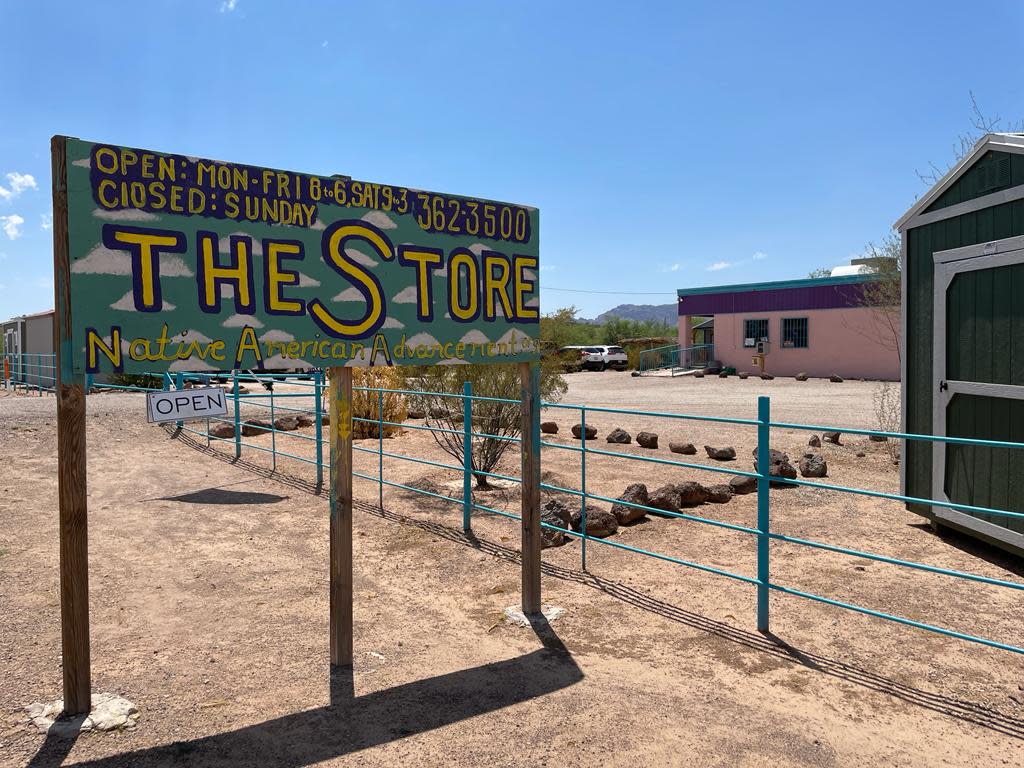
GUVO, Tohono O'odham Reservation — Selina Jesus filled her bottle from the wall-mounted spigot outside the town store, the product of a solar-powered system that pulls and collects water vapor from the air.
In the parking lot of the store, which is operated by the Native American Advancement Foundation, a nonprofit group founded by Tohono O’odham members, two large solar-panel units extract the little moisture they can from the dry Sonoran Desert air and produce water through a process called atmospheric water generation.
The new technology, developed and sold to the nonprofit by Scottsdale-based company Source Global, arrived less than a year ago in the Tohono O’odham district, about 25 miles southeast of Ajo. Its proponents hope it can solve drinking water access in remote places like this.
Many community members still lack running water because of infrastructure challenges, as do tens of thousands of people across Arizona. Some live in tribal or remote rural communities, others in cities suffering from plumbing poverty.
Tribal utilities have long strived to bring water service to residents. But change has been slow. Often, households are too far away from the main line for the costs to pencil out. In 2020, the Navajo Nation added nearly 60 free water stations, reducing the distance families must drive to haul water from 52 to 17 miles.
In the GuVo district of the Tohono O'odham Nation, water lines were installed about nine years ago, but fewer than half the people living on the reservation are customers of the utility.
More on Arizona Water: Buckeye nixed 6,000 homes — but that's not necessarily good news for water
Communities can lack potable water for reasons other than infrastructure. Installing treatment plants to improve water quality is often beyond the capacity or budget of small utility providers. And many tribes have limited access to water because of pending litigation with the state of Arizona. Their water right has to be settled in court and, for many tribes, the process has stretched for decades.
Then there can be other barriers, said Jesus, a resident of GuVo and NAAF senior director of programs. Unemployment rates on the reservation are high, and sometimes because of the financial burdens, she said, neighbors get their water shut off. If they are not connected to the delivery system, they still have to pay for gas or for a neighbor to drive them dozens of miles to the nearest water station.
Elderly folks, some of them grandparents taking care of kids, sometimes live on a social security check or other support, and with that very small income, she said, “they have to juggle what they're going to be paying for the month."
There is no silver-bullet solution. But partial fixes and new technologies to bring potable water to more rural residents are growing through tribal and university-led partnerships, as well as initiatives from nonprofits and the private sector.
Solar-powered nanofiltration and atmospheric water generation are some of the technologies that have been tried in areas without water service or communities with poor water quality. Among the projects are small mobile water-treatment units inside galvanized steel containers, water and energy systems built by Navajo students for their community, and the technology that produces water from the surrounding air.
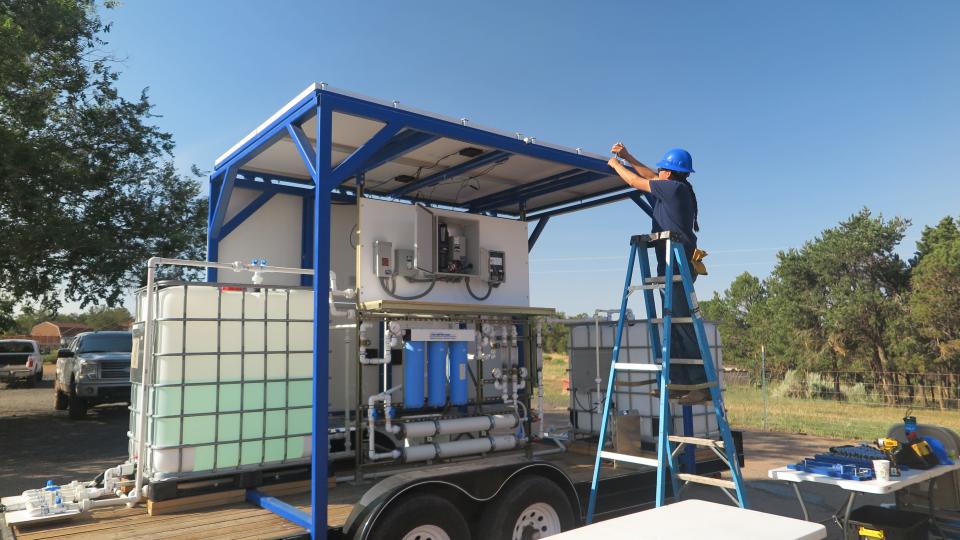
Water contamination harder to solve in small systems
In most Arizona counties, groundwater is the primary or only source of water.
Relying on one source brings risks. Supply might be more limited, and there is no alternative if that source becomes contaminated. Both things can happen. Sometimes, the water table is so low that the cost of drilling is prohibitive, and groundwater often holds higher concentrations of contaminants like arsenic and copper than surface water.
The presence of uranium, fluoride and lead can also make the water dangerous to drink.
Sometimes, in places where water contamination is high, so are treatment expenses. The burden of water pollution falls harder on small utilities, which face similar costs as larger systems for expensive water treatment but, because of a reduced customer base, collect less money from fees.
Water quality violations are also more common in water systems serving fewer than 3,000 people, according to a graduate research study from the University of Arizona.
Apache County, for example, had both the highest proportion of small water systems and the highest number of violations for arsenic, lead and copper.
The study also found a relationship between low drinking water standards and poverty levels. Lead violations associated with old pipes, were more common in zip codes with high poverty rates, and arsenic exposure was disproportionate in low-income groups and Hispanic communities, as was copper exposure in tribal communities.
Most alarming, study author Lina Benitez said, is that many of those communities also have a higher percentage of children under 5, who are more seriously affected by early exposure to contaminants.
Mobile treatment: How a purple school bus brings clean drinking water to Navajo Nation
A mobile water treatment system
In the fall of 2017, a unique school bus arrived in Leupp, a Navajo community about 25 miles east of Flagstaff.
Inside, a solar-powered desalination system purified groundwater.
The idea of a school bus treatment unit was conceived by Mark Sorensen, CEO of Star School, a pre-kindergarten and public charter school serving mostly Native American children. With grant funding, it was designed and built by University of Arizona engineers and Apex Applied Technology, a consulting firm that secures federal funds to improve the quality of life in tribal communities.
UA engineers had been working for nearly a decade on water purification systems in the Navajo Nation. But this was the first time the desalination system was put on wheels.
Most Leupp residents, like more than a third of people in the Navajo Nation, rely on hauled water and wells that might contain traces of arsenic and uranium, a legacy of old mines in the region.
The bus, partners thought, could serve as a pilot project to bring clean drinking water to those communities and educate young students about water treatment technologies. The system reduces concentrations of the contaminants to safe levels.
Five years later, the bus’s water system is still running and has multiplied.
Four new units, “water box” containers made fully automatic and deprived of wheels, sit as demonstration systems in other tribal communities. Some of the new units, improved by AATech and owned by Star School, can also be connected to the electric grid for backup and increased capacity. They produce from 500 to 1,000 gallons of clean water per day.
Some of the units were installed at the height of the COVID-19 pandemic to bring rapid relief to tribal members. Others help support food production.
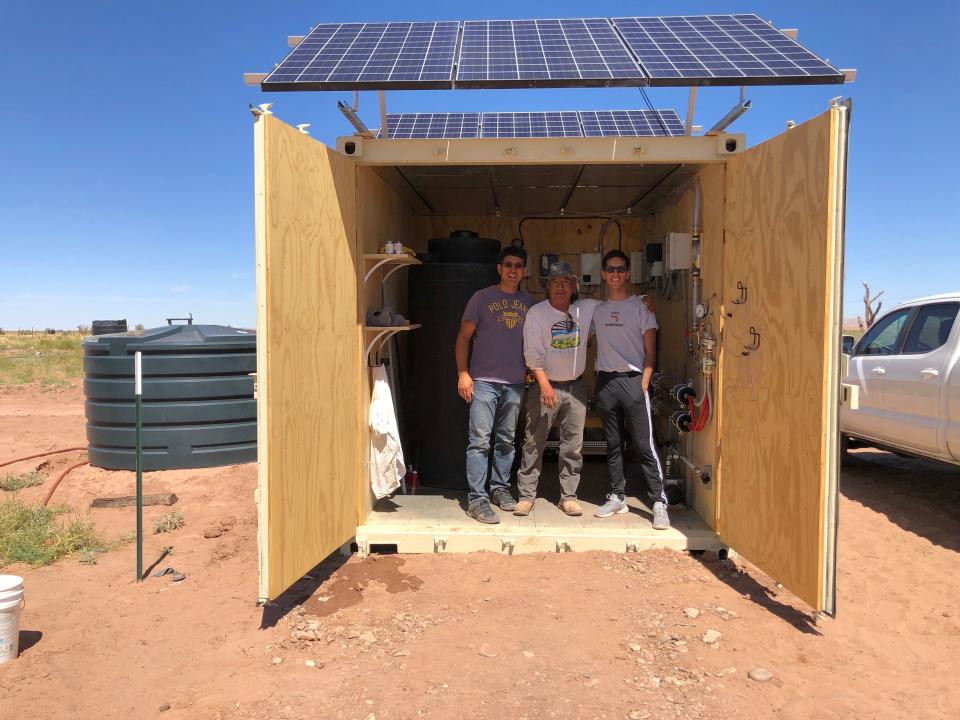
For the Nalwoodi Denzhone Community on the San Carlos Apache reservation, it was a game changer.
The nonprofit, dedicated to community revitalization and youth education, had been running a farm near Globe as a learning space for a long time. Last year, the group decided to become a licensed grower to provide healthy foods to the community.
"Luckily, we had that WaterBox already on hand," said Eric Shin, NDC director of operations.
“To have safe drinking water we actually have to go out and go to the local Safeway or take our 5-gallon water jugs and get those filled."
Most neighbors do the same. The levels of contaminants in the water are suitable for irrigation but don’t meet drinking water standards.
Now, the small desalination system and 500-gallon tank provide drinking water for the team and a washing station for produce cleaning, which is required for licensed growers.
The WaterBox also serves as a demonstration project. The hope is that the working water system at NDC can spark community members’ interest in installing similar units in their area and improve access to safe drinking water.
Colorado River shortage: How Colorado River cities are preparing for shortages with conservation and alternate sources
Training the next generation of solution-makers
Navajo college students are also building solar-powered desalination units.
Using a five-year National Science Foundation grant, the University of Arizona and Diné College partnered to train the next generation of scientists and engineers. The program, which works to address the water, food and energy needs of people living on the reservation, is led by Karletta Chief, a prominent Diné scholar and the director of the UA's Indigenous Resilience Center.
“When we talk about sustainability, about doing projects with communities, the most important part is actually the communities being part of the equation,” said Vasiliki Karanikola, part of the Indige-FEWSS program and a UA chemical and environmental engineering professor.
Karanikola worked with the students, both from the UA and Diné College, to build several off-grid water systems using nanofiltration, a water treatment technology that pushes pressurized water through a membrane to separate contaminants from water. They install the systems at tribal members’ homes in partnership with reservation-based consultant Sixth World Solutions.
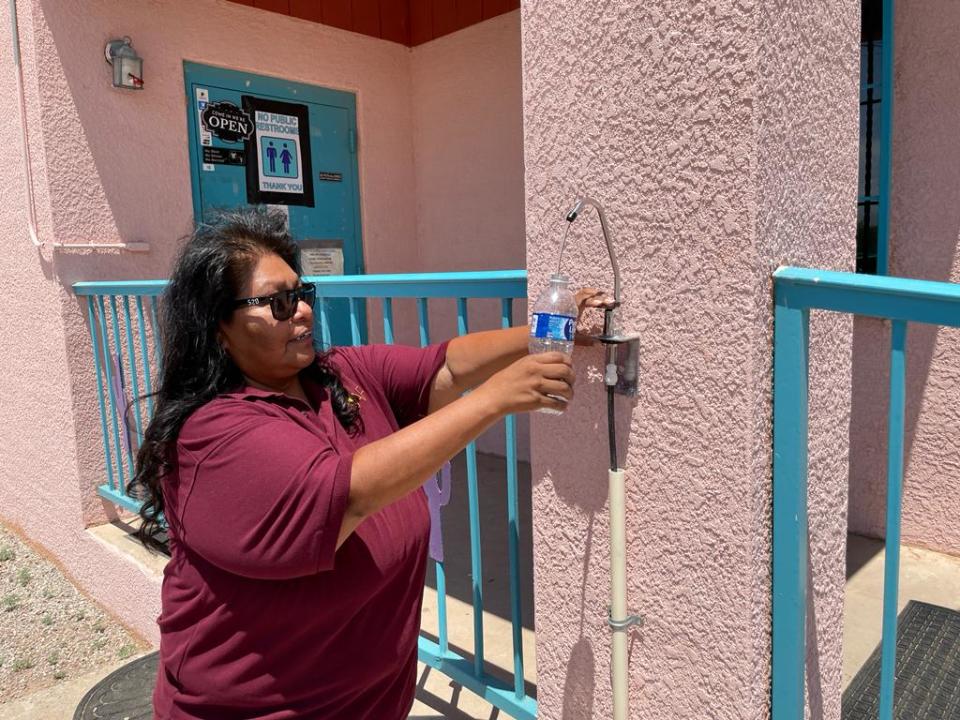
In some communities where contaminant levels are low, the team built solar-powered UV light systems for water disinfection.
These systems also reduce costs for water consumers. Because they have to haul water from 5-50 miles away, families can spend as much as $13 for 100 gallons of water. For other Arizona residents, that same amount of water costs less than $1.
“With solar nano-filtration we produce water at about $1.20 per 100 gallons,” Karanikola said.
The five-year grant ended this year, but other projects with the UA faculty and partners in the Navajo Nation were born. Karanikola believes it's the result of nearly a decade of close work with the community.
Water from thin air?
And then, there are other devices that don't treat water but produce it from desert air.
Hydropanels, solar-panel units that draw in air moisture, superheat it and efficiently collect it in its condensed form, will be installed in 800 Arizona homes through a $7.5 million state grant.
The technology owner, Scottsdale-based company Source Global, previously known as Zero Mass Water, has installed the hydropanels in over 50 countries since its launch in 2014.
"The very first projects were always places that needed it most," said Colin Goddard, who runs the company's programs in North America. Often, that was in rural villages in Ecuador, refugee camps in Lebanon and schools in Kenya. Some were also used in remote homes in the U.S.
"In a country where most people forget their tap and don't really think twice about it, you only really need to scratch the surface to realize not everyone is in that situation," Goddard said.
Arizona Climate Change: How climate change may leave some Sky Island wildlife species in Arizona with no place to go
The company has installed about 2,000 hydropanels in Navajo, Hopi, San Carlos Apache and White Mountain Apache homes.
Producing potable water from the surrounding air sounds like something out of a science fiction story, but the technology behind it — think of a sophisticated dehumidifier — has existed for some time.
The system sitting at the NAAF parking lot looks much like a normal solar panel but with patented parts inside it. The difference on the outside is that it growls and has an eight-gallon reservoir at the bottom.
“Effectively, what we're trying to do is get the inside of the machine as hot as we can so that even on a day like today, the air around the hydro panel is going to be cooler than the environment inside the machine,” said Thomas Borns, Source’s senior director of community engagement.
The growling comes from fans that draw ambient air and the water vapor in it. That air is pushed into the panels and superheated so it can condense vapor into “pure liquid water.” A unique material inside the panel helps make the collection more efficient.
Because the system collects only water vapor, Borns said, it leaves out any pollutants that might be in the air. Water then trickles into a reservoir with calcium and magnesium, so it's mineralized and is pumped out for consumption.
A computer inside the system also sends information back to Source technicians so they track performance and know when a part needs replacement.
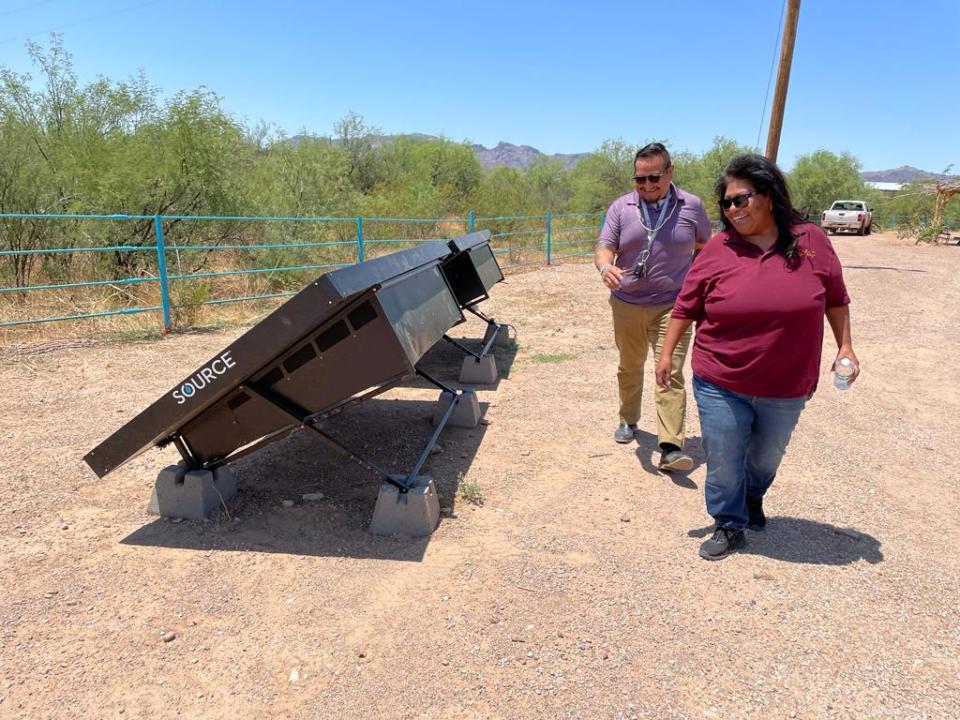
A small amount of water, but deeper research
Source Global will install 1,600 more hydropanels in tribal communities and rural areas, in partnership with Local First Arizona.
The money for the project, coming from American Rescue Plan funds, was awarded to Local First by former Gov. Doug Ducey's Office in 2022.
Local First is helping the company identify communities and households where the need is greatest, and will help establish partnerships with tribal members. NAAF also purchased the system to install in the GuVo Store and introduce neighbors and tribal leaders to the technology.
The project has few restrictions on who can benefit from it. As long as the applicant lives in a tribal community, a rural “colonia” in Southern Arizona, or a rural area outside of Arizona’s six Active Management Areas, they can apply online to receive a hydropanel kit.
"It is a first-come, first-served in that way,” Goddard said. “We do want to be thoughtful about trying to engage a variety of communities."
Yuma County, where water contains high levels of arsenic, is one of the areas that will benefit from the grant. So far, Source has installed 46 systems in the county. There are about 600 systems left to allocate, Goddard said.
In the NAAF store, the only grocery outlet within the GuVo district, the hydropanel was installed to attract neighbors' attention and introduce tribal officers to the technology. At least 56 systems will be installed in the Tohono O'odham Nation through the grant.
Many community members still rely on bottled water and have to drive to fill their tanks. Hydropanels bring some relief, even if meager.
In the Sonoran Desert weather, a system of two hydropanels produces only about one gallon of water per day, barely enough for the drinking water needs of two people. The cost of a two-panel system, with a life expectancy of 15 years, comes to around $6,000.
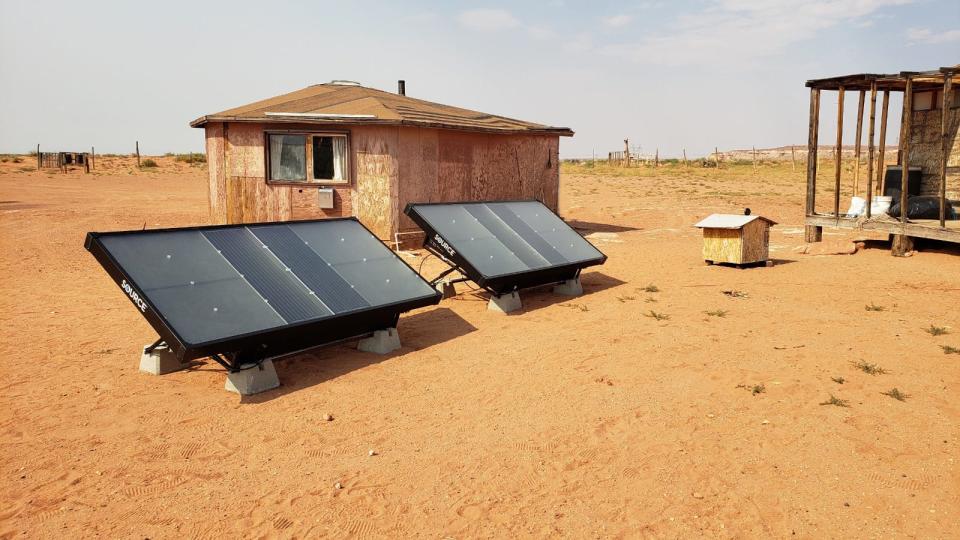
Some parts of the system have to be changed by a Source Global technician every five years or so. The state grant covers those costs, too.
"If you're looking at the next 10-15 years of living off bottled water this is cheaper in the long run,” Goddard said.
Clara Migoya covers environmental issues for The Arizona Republic and azcentral. Send tips or questions to clara.migoya@arizonarepublic.com.
Environmental coverage on azcentral.com and in The Arizona Republic is supported by a grant from the Nina Mason Pulliam Charitable Trust. Sign up for AZ Climate, our weekly environment newsletter, and follow The Republic environmental reporting team at environment.azcentral.com and @azcenvironment on Facebook, Twitter and Instagram.
This article originally appeared on Arizona Republic: Solar-powered technologies in Arizona make a dent on water access

